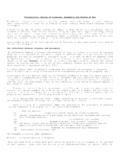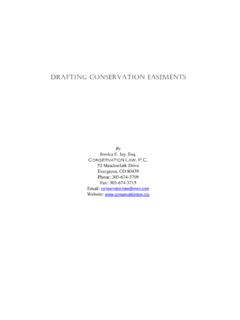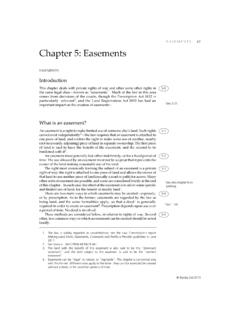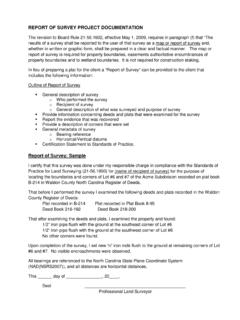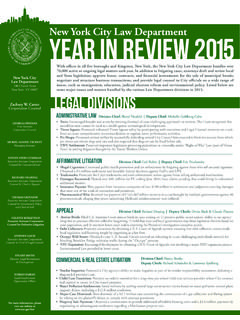Transcription of PRESCRIPTIVE EASEMENTS AND CONSIDERATION …
1 PRESCRIPTIVE EASEMENTS AND CONSIDERATION OF A PROGRESSIVERULE FOR RELOCATION OF SERVITUDES IN NORTH CAROLINA I. IntroductionOne may acquire an easement by prescription over the land of another. Green v. Barbee,233 77, 76 307 (1953). A PRESCRIPTIVE easement generally stands in all respects onthe same footing as an easement acquired by express grant. 25 Am. Jur. 2d, EASEMENTS andLicenses 45. However, PRESCRIPTIVE rights are not favored in the law since they necessarilywork corresponding losses or forfeitures on property owners. , EASEMENTS were only created by express grant. Id. Over time, courts createdthe legal fiction of a lost grant, which is generally regarded as the basis of prescriptiveeasement rights.
2 Id. The lost grant was based on one s possession and exercise of a right to aninterest in another s property over a long period of time, with the acquiescence of the owner. lost grant was predicated on the assumption that there must have been an express grantof rights by the owner to the person claiming the interest which has simply become lost, because had there not been a grant the owner would have put an end to the wrongful use or claimto the property. Id. The courts have generally upheld this legal fiction, not because thepresumed grant was actually made, but because public policy and convenience dictate that long-continued possession and use not be disturbed.
3 Id. II. Presumption of Permissive useA mere permissive use of a way over another s land, however long it may be continued,can never ripen into an easement by prescription. Potts v. Burnette, 301 663, 273 (1981). In contrast to the general rule followed in most states, our Supreme Court has statedthat we deem it the better-reasoned view to place the burden of proving every essential element,including non-permissive use, on the party who is claiming against the interests of the trueowner. Id. Thus, North Carolina has specifically rejected the view held in the majority of statesthat one s use of another s property is presumed to be non-permissive.
4 Presumption followed in North Carolina courts is that one s use of another s land isby permission. Therefore, to establish a PRESCRIPTIVE easement in North Carolina, one must firstovercome the presumption that the party is using the true owner's land with the owner'spermission. Pitcock v. Fox, 119 App. 307, 309, 458 264, 266 (citing Johnson , 96 App. 72, 74, 384 577, 579 (1989) and Dickinson v. Pake, 284 576,580-81, 201 897, 900 (1974)). In order to overcome this presumption, "[t]here must besome evidence accompanying the use which tends to show that the use is hostile in character andtends to repel the inference that it is permissive and with the owner's consent.
5 " Dickinson, at 581, 201 at 900; see also Cannon v. Day, 598 207 (2004)(finding thatevidence was sufficient to overcome presumption of permissive use where neighbor spredecessor-in-interest never gave permission to use the road and landowners still claimed it astheir own, landowners performed maintenance required to keep the road passable, andlandowners used the road for over 20 years as if they had a right to it). A party's [e]ntitlementto an easement by prescription is restricted because a landowner's mere neighborly act ofallowing someone to pass over his property may ultimately operate to deprive the owner of hisland. Johnson v. Stanley, 96 App.
6 At 74, 384 at 579 (1989) (quoting Potts , 301 663, 667, 273 285, 288 (1981)). Therefore, mere use alone ispresumed to be permissive, and, unless rebutted will not ripen into a PRESCRIPTIVE easement. Johnson v. Stanley, 96 App. at 74, 384 at 579 (citing Dickinson v. Pake, 284 , 580-81, 201 897, 900 (1974)).Evidence that permission was neverrequested or sought is tantamount to an assertion that the person is merely using the road or pathin silence. Godfrey v. Van Harris Realty, Inc., 72 App. 466, 469-70, 325 27, 29(1985). North Carolina courts have held that neither law nor logic can confer upon a silent use agreater probative value than that inherent in a mere use.
7 Henry v. Farlowe, 238 542, 544,78 244, 246 (1953). Thus, under North Carolina law, one s use of a way over another sland in silence is presumed to be with permission. Id. III. Creation of PRESCRIPTIVE EasementsIn order to establish an easement by prescription, the claimant must meet the criteria setout in West v. Slick, 313 33, 326 601 (1985) use must be adverse, hostile, or under a claim of right; use must be open and notorious;3. The adverse use must be continuous and uninterrupted for a period of twentyyears; must be substantial identity of the easement The Use Must Be Adverse, Hostile, or Under a Claim of RightTo establish that a use is hostile, it is not necessary to show that there was a heatedcontroversy or a manifestation of ill will, or that the claimant was in any sense an enemy of theowner of the servient estate.
8 Brunswick v. State of North Carolina, 329 37, 404 677(1991). A 'hostile' use is simply a use of such nature and exercised under such circumstances asto manifest and give notice that the use is being made under a claim of right. Dulin v. Faires,266 257, 260-61, 145 873, 875 (1966). There must be some evidenceaccompanying the user which tends to show that the use is hostile in character and tends to repelthe inference that it is permissive and with the owner's consent. Dickinson v. Pake, 284 , 580-81, 201 897, 900 (1974). Evidence showing that the owner of the servient estateagreed to let people use the path located thereon tends to show the use is not adverse or hostile,and in fact, is evidence of permissive and non-hostile use.
9 Nichols v. Wilson, 116 , 448 119 (1994). Where persons claiming a PRESCRIPTIVE easement over the lands ofanother did not engage in the upkeep or maintenance of the roadway, such evidence may be usedas evidence that persons seeking to establish the PRESCRIPTIVE easement did not use it under a claim of right. taken to maintain or improve a roadway underlying the PRESCRIPTIVE easementmay be sufficient evidence to rebut the presumption of permissive use and demonstrate adverseand hostile use. Perry v. Williams and Holloman, 84 App. 527, 353 226 (1987). InDickinson, Plaintiffs raked leaves and scattered oyster shells in the roadway, performing theslight maintenance required to keep the road in passable condition.
10 Dickinson, 284 576,201 2d 897. In Potts, Plaintiffs, on at least one occasion, smoothed, graded, and graveledthe road, and on other occasions, attempted to work on it. Potts, 301 663, 273 2d Perry, Plaintiff's agent testified at trial that he placed brickbats and rocks in holes, hauled sandto fill in low areas, and cut trees and bushes in order to maintain the roadway for plaintiff's , 84 App. 527, 353 226 (1987). Such actions have been held sufficient toovercome the presumption of permissive use. A claimant may also establish a PRESCRIPTIVE useunder a claim of right where he or she alleges that the disputed road was graveled, opened,maintained by plaintiff, used by the public, and as a mail and school bus route for theprescriptive period.
